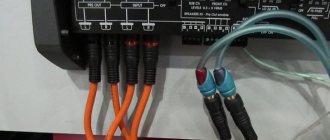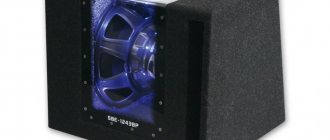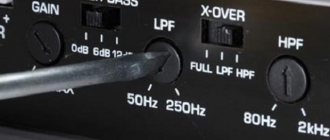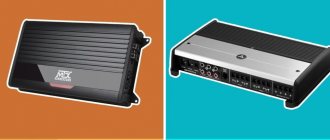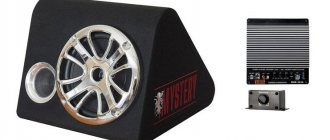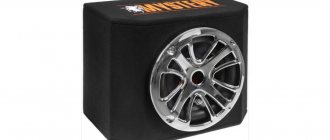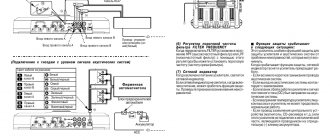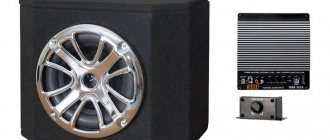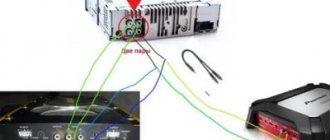HPF / LPF (HPF / LPF)
Hight pass filter (HPF), also known as a high-pass filter (HPF), filters out (cuts off) low frequencies, leaving high ones.
When setting up a subwoofer amplifier, set the control to about 20 Hz to cut out infrasound and not waste energy, since you won't hear it anyway. For mid-range speakers, the HPF is set around 80 Hz to remove the low frequency range for which the speaker is not designed and will not be able to play it. If you have separate channels or even a separate amplifier for tweeters (tweeters), the HPF is set in the region of 3000 - 5000 Hz, depending on the model, so as not to burn them.
All figures given are approximate, to obtain more accurate and safe values, study the characteristics of your speakers!
Low pass filter (LPF), also known as a low pass filter (LPF), is the opposite of HPF and cuts off the upper frequencies, leaving the lower ones.
For subwoofers, it is set in the region of 50-80 Hz, depending on the type of design (ZYA, FI, etc.) in order to cut off frequencies for which the subwoofer is not intended. The same goes for midrange drivers, cut them around 1400-1600 Hz.
If possible, you can limit tweeters to 20,000 Hz, but this is not necessary.
How to properly set up an amplifier in a car
Selecting the amplifier sensitivity level
Roughly speaking, volume (although this is not entirely true). By turning the knob from a larger number to a smaller one, we increase it.
Filters
LPF - filters out low frequencies.
HPF - filters out high frequencies.
Let's say, by setting the low-pass filter control to 50 Hz, the speaker will receive frequencies up to 50 Hz.
Attention: on different amplifiers, options are possible - either it will be a selector with a choice of filter type and one regulator, or separate regulators for the high-pass filter and low-pass filter.
In some amplifiers, it is possible to turn on both filters, so by turning on the low-pass filter and the high-pass filter, we can get a band-pass filter. For example, by setting the low-pass filter to 200 Hz and the high-pass filter to 50 Hz, the acoustics will reproduce a signal in the range from 50 to 200 Hz, respectively.
Some older amplifier models have fixed filters. Filtering is selected using the selector.
Subsonic
For the most part, it is necessary for subwoofers (in bass reflex design) But it can also be used as a high-pass filter.
There are also subsonics with a fixed filtering frequency.
Bass Boost
Allows you to increase the volume at a certain frequency.
Attention: the bass boost frequency is usually fixed. But some amplifiers have an additional regulator that allows you to select the required frequency.
There are also bass boosts with a fixed gain.
Phase regulator
Serves to coordinate the operation of the subwoofer with the front. And in general for more precise tuning.
There are also fixed phase controls.
Gain Level
Gain (sensitivity) is often confused with volume, but this is not entirely correct.
Gain is an adjustment of the amplifier's input sensitivity to match the radio. But let’s not get into the weeds and consider this setting from the point of view of what is useful for the user.
Sometimes the Volts (V) value indicated on the regulator can be misleading. The fact is that sensitivity is measured in Volts. The smaller V, the higher the sensitivity, the louder the speaker will play and vice versa.
To begin with, it will be useful to watch a clear video about how gain works on an amplifier:
Adjusting gain by ear (method 1)
Having a good sub link, do not use an equalizer and various bass enhancers, forget about bassboost on the amplifier - so before adjusting the gain, make sure that all this is turned off!
Set the control to minimum and play music that you usually listen to. Turn up the volume of the radio by 3/4 of the maximum; if you hear distortions in the sound of the subwoofer earlier, stop and turn down the volume a couple of notches. Go to the amplifier. Have an assistant slowly turn up the gain control until new distortion appears, and when you hear it, stop the rotation and turn it down by 10%.
Adjusting gain by ear (method 2)
If you don’t trust your hearing and are afraid not to hear changes during time, then use a more accurate method - using sinuses.
If you are tuning a subwoofer, then use 40 Hz, if your case is tuned above 40 Hz or you have a closed box, then take 50 Hz (download sines in the Downloads section). To set the gain for the midbass amp, use 315 Hz.
Sine or tone (in our case) is a tone signal of a certain frequency, changes in the sound of which you can easily hear
Set the gain to minimum, turn on your sine and turn up the volume of the radio. When changing the sound of the tone signal, stop and turn it down a couple of notches (set the maximum volume limit to this value if your radio has such a function). Go to the amplifier. Similarly to the first method, add gain. When the sound changes, stop and turn it down 10%.
Adjusting Gain Using a Multimeter or Oscilloscope
Adjusting the gain level using instruments is a smart and precise adjustment. At the same time, neither the speaker nor your ears are strained. This setup is shown in detail in the video on our YouTube channel:
Correctly setting up a subwoofer in a car
Read more
What is an athermal windshield for a car?
A subwoofer is an important part of a car's sound system. It is this that allows you not only to listen to music, but also to feel its depth and volume with your whole body. It is the correct setting of the subwoofer in the car that can significantly increase the pleasure of listening to music.
The content of the article:
There is an opinion that a subwoofer in a car is needed only for young people who listen to gut-wrenching African-American rap. Actually this is not true. The subwoofer only allows you to expand the dynamic range of playback. After all, low frequencies are present in almost any musical material, even in classical music.
But small door speakers do not allow you to listen to low bass. But the subwoofer copes with this perfectly. Naturally, if the subwoofer is made correctly and the subwoofer is configured correctly in the car.
What should be the correct setting for a subwoofer in a car?
Setting up the subwoofer should be done at the stage of designing the speaker box. During this, many different parameters are taken into account: the music that the owner will listen to most often, the amplifier that will work with the speaker and the car in which the subwoofer housing will be installed.
When designing a box, an important role is played by the parameters of the speaker, which determine in what acoustic design it can work. For example, if a speaker is capable of playing well in a bass reflex enclosure, its port can be adjusted either higher or lower, depending on the music you prefer.
Of course, if you get a subwoofer in a factory case, its customization options are limited. But with the right approach, achieving acceptable sound is quite possible. Where to start setting up a subwoofer?
Setting up the LPF (low pass filter) filter
Naturally, the speaker must be correctly connected to the amplifier. First, you need to turn on a filter on the subwoofer amplifier or head unit, which is usually designated as LPF (low pass filter). That is, this filter allows low frequencies to reach the speaker while cutting off high frequencies. For example, a popular cutoff frequency for subwoofers is 50 to 63 Hz.
The first stage of tuning is to set the filter to approximately this frequency. Then this value will need to be slightly adjusted. Moreover, if it is possible to use LPF on the head unit, you should enable it there. Otherwise, you can adjust the cut using the “twist” on the amplifier. There is no need to turn on the filter on the GU and the amplifier at the same time.
Setting up "Sabsonic"
Afterwards you need to use a filter called “sabsonic”. In essence, this is a high-pass filter operating in the sub-bass region. Simply put, it cuts off infra-low frequencies from the signal and passes everything higher. Subsonic is not available on all amplifiers. But if your speaker operates in the acoustic design of FI or HF, then you need to choose an amplifier that has such a filter.
Why does he need a “sabsonic”? The fact is that the subwoofer speaker will also try to reproduce frequencies that lie outside the audible range, for example 20-25 Hz and below. At such frequencies, the diffuser stroke increases, which can lead to the coil leaving the gap and damaging it. Sabsonic cuts off all the “infra” and does not allow the speaker to exceed the stroke. In addition, the quality of reproduction of the desired bass range only improves, and the volume increases.
The “Sabsonic” should be tuned approximately 5 Hz below the tuning frequency of the bass reflex port. For example, if its tuning frequency is 35 Hz, then the subsonic should be tuned to 30 Hz. To do this, you need to turn on the switch and rotate the “twist” to the required numbers.
What you need to know about filters
Another thing to remember about filters is that none of them cut the signal sharply, like a knife. That is, it does not happen that the LPF is set to 63 Hz, and there is no sound at 64 Hz. All frequencies higher will be attenuated, with a smooth decline. And the smoothness of this decline will depend on the so-called filter order.
A 4th order filter will give a flatter rolloff, while a 1st order filter will give a steeper rolloff. Some head units allow you to select the filter order. This is important for setting the “junction” of the subwoofer and midbass operating areas.
Adjusting the subwoofer input sensitivity “GAIN” or “LEVEL”
Another important step in setting up a subwoofer is adjusting the subwoofer's input sensitivity level. It is located on the subwoofer amplifier and is designated by the word “GAIN” or “LEVEL”.
It looks like a “twist” with numbers, for example, from 0.3 to 5 V. This is not a volume level, as some people mistakenly think, although when set to maximum values, the volume does increase. This function is needed to match the level of the head unit and amplifier.
“GAIN” is adjusted using different methods. But their essence is something like this: a music signal in the form of sines with a certain frequency is supplied to the subwoofer. The level of input sensitivity is minimal.
Gradually increase the volume on the head unit until audible distortion appears. After this, the volume knob is turned back so that the sound becomes clear again. Then the “GAIN” is adjusted in the same way, turning the “knob” until signal distortion appears. Then they return it a little back. Setting up the subwoofer in the car will be more accurate if you use an oscilloscope in the process.
Choosing a speaker system for a car
Adjusting the subwoofer's acoustic phase
Setting the acoustic phase of the subwoofer is also important. Without going into the nuances of terminology, it should be said that correct phasing allows you to ensure the sound of the “sub” in the front, along with the front speakers. If the subwoofer can be heard from behind, from the trunk, then something was done wrong.
Many amplifiers have a phase shifter “twist” that allows you to smoothly rotate the phase. Therefore, it is advisable to purchase just such amplifiers. If this is not possible, you can rotate the phase on the PG, if it has such a function. Or you can simply swap the positive and negative wires on the speaker.
Setting delays
The next step in setting up a subwoofer in a car is setting the delays. But this is only possible on a processor head unit or with an external processor. Some acoustic designs, such as FI, do not always have good impulse response, so the bass may be a little late. This is not always pleasant to hear.
For example, the front speakers played a note, and a split second later the sub played. To prevent this, the delays are adjusted, which allows the front speakers and subwoofer to play simultaneously.
Interface between subwoofer and midbass
The last adjustment of the subwoofer in the car is the “matching” of the front speakers with the subwoofer. For example, if the subwoofer is “cut” at 63 Hz at the top, and the “front” at 100 Hz at the bottom, then a gap may form between them. If the cutoff frequencies are different, a hump may form. In order for the setting to be correct, it is necessary to make this section of the frequency response smooth. To do this, you can slightly change the cutoff frequencies LPF and HPF. This can be done by ear or using any RTA analyzer.
Bassboost
Bassboost - increases the volume at a certain frequency, usually 40-45 Hz.
When using a bass boost, the chance of burning the subwoofer increases sharply, since clipping occurs much earlier. In most cases, bassboost is not needed and if you are a beginner, then just accept the rule “Don’t touch bassboost!”
Experienced people can use it to increase the frequency response shelf in order to draw out dips in certain frequencies, but these are already deep settings and the effect does not always justify the risk.
Setting up for working with a subwoofer
Let's use a simple example to see how to configure an amplifier for a subwoofer. Let it be connected to Rear on the amplifier, and the front speakers connected respectively to Front. Experts recommend the following settings:
- The bass boost is set to zero for both channels. The level or gain is also set to zero.
- The crossover for the Front channel is set to the HP position.
- For the Rear channel, the crossover is set to the LP position.
- Next, all that remains is to adjust the sensitivity by adjusting the gain so that the sound is as harmonious as possible. It can be adjusted for front and rear channels as desired.
Here's how to set up an amplifier for a subwoofer in practice. As you can see, there is nothing complicated about this. All you need is good hearing, acoustic tracks and enough free time.
What to collect from?
You should carefully select components. There are many selection criteria other than the sound of certain brands. Be sure to take into account the dimensions depending on the intended location of the audio system. Just in case, select parts with at least two pairs of linear outputs. And look at the appearance: the design should be combined with the interior of the cabin.
Once you decide on the sound, pay attention to the place where you are going to put it. Dimensions and installation depth play a huge role when installing the system. The optimal choice is two-component speakers from a well-known brand.
Lately, door podiums have become quite popular. True, the “filling” of the door and its trim often take a long time to adjust to the purchased components.
Speakers aren't everything
The choice of a subwoofer is determined by the same criteria as acoustics: diameter, installation depth and sound feature. Therefore, the advice related to acoustics will also apply to the subwoofer.
An amplifier is an essential element of any audio system. Your choice should fall on a renowned company. These, as a rule, are made of more resistant materials and high-quality components, and can also withstand increased loads.
Red or blue?
Don't forget about the wires! Wires are divided into three types: acoustic, interconnect and power. Power ones are needed to connect the head unit and amplifier and the power source. There is an opinion that the more expensive the better. In our case, this is true only for wires of the highest price category. Daxx, Stinger, Belsis and Chernov wires perform well.
Sometimes a capacitor is added to the system to eliminate bass sag when there is insufficient power from the generator and battery. You may encounter such situations if, for example, you are going to participate in car audio competitions. Please note that for a power of 500W, 0.5F is enough. Focus on models with automation if you don’t want to bother with connections. If you are making a system “for yourself,” a capacitor is not needed.
Connecting interconnect wires and control (REM)
To lay the cable, you need to find the linear output on the radio. The linear output can be recognized by the characteristic “bells” that are located on the rear panel of the radio. The number of linear outputs differs in different radio models. Usually there are from one to three pairs. Basically they are distributed as follows: 1 pair - you can connect a subwoofer or 2 speakers (labeled as SWF) If there are 2 pairs of them, you can connect 4 speakers or a subwoofer and 2 speakers (outputs are labeled F and SW), and when there are 3 pairs of linear wires on the radio, you can connect 4 speakers and a subwoofer (F, R, SW) F This is Front i.e. front speakers, R Read rear speakers, and SW Sabwoorer I think it’s clear to everyone what that is.
The connection will require an interconnect wire, which should never be skimped on. It is prohibited to lay the interconnect cable near the power wires, as various types of noise will be heard when the engine is running. You can run the wires both under the floor mats and under the ceiling. The latter option is especially relevant for modern cars, in the interior of which there are electronic accessories that create interference.
You also need to connect the control wire (REM). As a rule, it comes with interblock wires, but it happens that it is not there, purchase it separately; it does not need to be of a large cross-section - 1 mm2 is quite enough. This wire serves as a control for turning on the amplifier, i.e. when you turn off the radio, it automatically turns on your amplifier or subwoofer. As a rule, this wire on the radio is blue with a white stripe; if it is not there, use a blue wire. It is connected to the amplifier to a terminal called REM.
Find out in advance what you need
Before purchasing components, be sure to determine the wiring diagram. It determines exactly what you need, as well as a theoretical price range. The following are the most common and convenient schemes.
- Head unit - front subwoofer - 4-channel amplifier for front and subwoofer.
Classic. Budget-friendly, easy to install and configure. It is also good because it saves space in the car. The disadvantages include the low power of the system, but this does not significantly affect the sound quality. - Head unit - front - rear - subwoofer - 5-channel amplifier for front, rear and subwoofer.
It is based on the previous scheme. It differs only in that it provides sound in the rear part of the cabin. The setup is more difficult than the first scheme, and it is not always possible to achieve the desired result. - Head unit - front - subwoofer - 2-channel amplifier to the front - 2-channel amplifier to the subwoofer.
Do you like powerful bass? Then this diagram is for you. We get more power by connecting a two-channel amplifier to a subwoofer with a bridge. - Head unit - front - subwoofer - 4-channel amplifier for the front - 2-channel amplifier for the subwoofer.
The most expensive of the presented schemes. And the best. Sound quality and power are achieved through channel-by-channel amplification.
Setting up an amplifier for the front: how to connect via, step-by-step instructions
Many car owners do not know what tuning an amplifier to the front is. There are several options for self-adjustment. The choice of method depends on the needs of the driver.
What is front amplifier
Before connecting the front of the amplifier, you must carefully examine the panel. This will help determine the output to the subwoofers. There are anterior and posterior channels. The first ones are designated by the inscription REAR. The latter have a FRONT pointer. Rear channels are often called rear channels. The front is an amplifier for multi-channel audio systems.
How to connect the front
To connect the front through an amplifier, follow the step-by-step instructions. It consists of several successive stages. Otherwise, problems may arise if the car owner connects the system to the output of the rear speakers:
Which radio do you recommend buying?
- 4734 votes - 50% of all
- 1366 - 14% of all
- 1042 votes - 11% of all
- 814 - 9% of all
- 640 - 7% of all
- Other... 4%, 369 369 - 4% of all
- 151 votes - 2% of all
- 2%, 147 147 - 2% of all
- 141 votes - 1% of all
- 93 votes - 1% of all
- Include wiring from the audio system speakers with the required connectors at the front.
- Connect the radio by connecting the required cable to the player in the car.
- Distributes a sound signal. The amplifier must independently supply a pulse to the subwoofer and high-frequency speakers. The same applies to mid-range speakers.
Connecting the front through an amplifier will help you adjust the desired parameters of the device. This will be extremely easy to do. Before setting up, you need to decide on the control options during the connection process. Each amplifier has a Crossover Selector. It is designed to switch filters. When the device operates in the LP position, it operates at low frequencies.
Are you a car driver?! Then you can take this simple test and find out... Go to the test »
If you connect the AP, the amplifier is with modifications deactivated. There is a special regulator on the rear panel. It is used to change frequencies at the cutoff of filters. The power is adjusted by using Level. It will allow you to select the desired level. Bass Boost enhances low frequencies.
How to set up the front
The initial adjustment of the edge on the amplifier involves adjusting the crossovers and frequency level. The reason for the enhancement does not matter. To configure the amplifier taking into account the front parameters, you need to disable modifications and sound adjustments. When this is not possible, the sound control is set to zero. It is advisable for motorists to take into account that 2 procedures cannot lead to the same result.
Passive crossovers are set to medium high-frequency power. A similar action will be needed when turning off RF signals other than 0. When adjusting, set the value to 3 dB. For the low-pass filter of active crossovers, the indicators are adjusted to the same values. They range from 75 to 80 dB.
The sound gain on the channels should be at a minimum level.
The value is preferably the same as on acoustics. Completing all steps involves adjusting the connected amplifier to the connected setup to the front.
After the necessary preparation, the input sensitivity of the system is adjusted. If you follow the included guide, you may notice an incorrect ratio. Therefore, they set the indicator based on personal feelings. However, you should not choose the maximum level. The gain value is reduced to reduce the volume headroom. This allows for better sound quality.
To determine the correct gain value, it is recommended to listen to music. Then the setup will be more effective. In individual audio files, the value is increased until sound distortion appears. Then the indicator is reduced. For high volume, the level of noise occurrence is determined. After completing the gain adjustment, proceed to setting the subwoofer.
To configure channels, connect the wire from the installation to REAR. The front speakers are connected with a cable to the connectors. Then set the low frequencies to zero. It should be the same for both subwoofer channels.
Finally, the speaker crossover is installed on the HP. To adjust REAR, select the LP mode. Then the phase setting parameter is changed. This will make the sound more harmonious.
You may also like
Source: https://omagnitolah.ru/podklyuchenie/usilitelya-pod-front.html
We collect
First, you should do the wiring. We select the cross-section of the power wire corresponding to the total power of the amplifier and head unit. We pull the plus and minus into the interior. Remember: wires passing through metal must be covered with a piece of plastic or rubber tubing to avoid a short circuit to ground.
The positive wire must be connected through a bulb with a fuse whose rating corresponds to the fuse on the amplifier. The flask must be positioned no further than 30 cm from the battery.
Run the power wires through the power distributor to the head unit and amplifier. They should be soldered to the head unit wiring harness, run the positive wire through the plug fuse. Protect the solder joint with heat shrink casing. Connect the block to the head unit, the interconnect wires to its linear outputs and install it in its original place according to the attached instructions. Crimp the ends of the power wire going to the amplifier with terminals.
Important!
It is better to run all wires separately from each other, although an intersection of 90 degrees is allowed.
Pay attention to the location
Place the high-frequency speakers on the lining of the windshield pillars, approximately at eye level and turn them towards the glass. So, they will work as a reflection, creating the width and height of the sound stage. To put it simply: we point the left speaker towards the passenger seat, the right one towards the driver’s seat.
When you're done connecting, double-check that everything is correct. After that, turn on the head unit and you can start setting up.
Connect the amplifier and install the subwoofer. If you have a sedan, then turn the sub towards the back of the passenger seats. If it’s a hatchback or station wagon, then go to the fifth door. Now you can connect the subwoofer!
Good nutrition is the key to success
The amplifier connection procedure begins with the power wires. Wiring is the most important element of a car audio system; the volume and sound quality depend on it. Amplifiers need a stable power supply, otherwise the power will not be enough and the sound will become distorted. To understand why you need to pay attention to the quality of wiring and how it affects the sound reproduced by a loudspeaker, you need to know what a music signal is.
Some suggest that it represents a sine wave, however, the musical sinhala is characterized by a large difference between the normal and peak value. If sharp signal bursts are not important for car speakers, then in the case of an amplifier the situation is completely different. If the signal exceeds the permissible power for even a second (or even a millisecond), then these “anomalies” will be audible even to those who cannot boast of a good ear for music.
If the car amplifier is connected properly, the signal will flow through the wires undistorted. Carelessly done work or incorrectly selected wire cross-section will result in the sound being more compressed, rough and sluggish. In some cases, wheezing may also be clearly audible.
How to choose a wire cross-section?
Wire is the most common metal with a certain level of resistance. The thicker the wire, the lower the resistance of the wire. To avoid sound distortion during large voltage fluctuations (for example, when playing powerful bass), you must install the correct gauge wire.
It is worth noting that the cross-section of the positive cable should not be larger than the negative one (the length does not matter).
An amplifier is considered to be a rather electrically intensive device. For its effective operation, high-quality grounding is necessary so that it is possible to receive the necessary energy from the battery. To choose the correct wire cross-section, you need to make some calculations. First, look at the instructions for the amplifier (or directly at the box from the manufacturer, if there is no documentation, use the Internet) and find the rated power value (RMS) there. Rated power is the signal power an amplifier can deliver over an extended period of time to one channel of 4 ohms.
If we consider four-channel amplifiers, they usually have a power of 40 to 150 watts per channel. Let's say that the amplifier you purchased produces 80 watts of power. As a result of simple mathematical operations, we find out that the total power of the amplifier is 320 W. Those. How did we calculate this? It’s very simple to multiply the rated power by the number of channels. If we have a two-channel amplifier with a rated power (RMS) of 60 W, then the total will be 120 W.
Setting details
After connection, the installed system must be properly configured. Tuning means setting the cutoff frequencies for acoustics and subwoofer on the amplifier, setting the incoming and outgoing sensitivity. As well as setting up the sound processor, if available.
Imagine that the filters in the amplifier are better than those in the head unit. And set all settings on the head unit to 0.
- Set the filter for the subwoofer channel to “LPF”. Set the crossover cutoff frequency from 50 to 70 Hz.
- Front channel filter to “HPF” position. The frequency is also in the range of 50-70 Hz.
- Adjust the sensitivity as follows: on the amplifier set the setting to “0”, on the head unit increase the volume to the maximum value. Then turn the sensitivity control on the amplifier upward until noticeable distortion appears in the sound of the system. Turn it down and the sensitivity is adjusted.
Important!
If the bass is localized on the subwoofer, then it should be connected in antiphase: turn the phase adjustment knob 180 degrees. If it is not there, swap the “+” and “-” in the subwoofer connection.
Launch everything and listen. If, when you start the radio, you hear clicks in the subwoofer and crackling sounds in the speakers, then check the wiring and, if necessary, rewire.
High-quality subwoofer setup in a car
Factory subwoofer settings do not always reflect the desired sound. In order for the subwoofer to reproduce low sound frequencies as accurately as possible, it must be pre-configured. In addition, setting up a subwoofer in a car allows you to expand the sound range and give it a characteristic color.
Music for setup and testing
Regardless of what style of music will most often be listened to through the car's audio system, the subwoofer must be configured optimally for all areas that are characterized by a low frequency spectrum. It is divided into two types of low frequencies:
- useful lows - add richness;
- Parasitic lows are not perceptible to the human ear, but are felt on a physical level in the form of mild discomfort.
The setting involves precisely getting rid of or reducing parasitic lows, the frequency of which is from 30 to 40 Hz. They are mainly used in electronic music compositions and are a characteristic feature that should not be removed. Therefore, it is not advisable to use electronic music for tuning. The optimal material for testing would be to use compositions with classical instruments. This will allow you to compare the sound of familiar instruments and determine spurious sound frequencies, since bass lower than 30 Hz is rarely found in classical music.
There are also special programs for tuning speaker systems, tone generators that help configure a car subwoofer as accurately as possible by playing sound in a user-specified frequency range.
First step: turning on the LPF filter
LPF (Low Pass Filter) is a low-pass filter that allows the speakers to play the bass specified during setup, while attenuating the presence of high sound frequencies. It can be located on the car's head unit or amplifier and is designated LPF or LP.
It must be turned on in the low frequency range 50-63 Hz. This parameter will be further adjusted after the settings of the remaining filters have been set. If the LPF filter is located both on the car radio panel and on the subwoofer amplifier, you only need to turn it on on one device. It would be rational to choose a radio, since adjustments on the amplifier are a little more difficult.
Second step: adjusting the subwoofer speaker frequency
The frequency filter controls the subwoofer's playback frequency. It looks like a gear (phase shifter) with a hole for adjustment with a screwdriver in the center and is designated Subsonic. Adjusting this filter will remove low frequencies that are beyond the audibility range of the human ear and increase the service life of the subwoofer cone by preventing oscillations beyond the limits of capabilities. It is optimal to adjust the frequency five parameters lower than the standard bass reflex frequency of the subwoofer, which is indicated in its technical documents.
Third step: adjust output sensitivity
The output sensitivity adjustment filter also looks like a wheel for scrolling with a screwdriver and is designated “GAIN” or “LEVEL”.
There is a misconception that this parameter is responsible for the volume of the subwoofer, in fact this is not the case, even though when set to the upper positions the volume does increase. This filter is responsible for the coordinated operation of the head unit and subwoofer, and is configured using a specific method that has four simple steps:
- set the controls on the radio and amplifier to minimum and the sound signal will sound to check;
- the volume gradually increases until the first distortions in the sound appear, after which it returns to the last position at which there was a clear sound;
- then the regulator on the amplifier rotates upward until the first sound distortions appear;
- as soon as distortions appear, the regulator returns to the extreme position at which they did not exist.
Fourth step: adjusting the acoustic phase
In order for the bass to sound in harmony with the other frequencies protruding from the front speakers and at the same time there is no perceived separation on the sides of the car, you need to correctly adjust the acoustic phase. This parameter is adjusted according to the driver’s personal feelings and is regulated by the Acoustic phase phase shifter, which is located on the front panel of the amplifier. You should gradually rotate the filter adjustment phase shifter clockwise until the front speakers and subwoofer begin to play in the same plane/acoustic phase (there will be no sensation of separate bass output from the rear). To check compositions, you need to listen to them in the driver's seat, where the sound separation is always more noticeable.
Watch the setup video:
Fifth step: adjusting the frequency junction
The final stage of setup is to adjust the sound of the midbass and subwoofer to a harmonious, comprehensive sound of music. During the preliminary setup, the LPF parameters were already set, which may have a difference with the low frequencies of the front speakers. Because of this, noticeable gaps may occur during playback. For example, if the LPF was set to 50 Hz, and the front speakers are running at 100 Hz, the sound will occur with a frequency dip in the range from 51 to 99 Hz. This does not mean that the filter will cut them off completely. It only smoothly reduces the sound of frequencies lying outside the specified parameter, and does not cut them out completely, but it is still too noticeable to the ear. To eliminate this effect, additional correction should be made using the LPF filter parameter. To do this you need:
- Play music rich in low frequencies through the speaker system.
- Turn the filter phase shifter several positions counterclockwise. This adjustment evens out the sound.
- If the dips are still noticeable. then the filter phase shifter rotates three phases in a clockwise direction.
Tips for setting up a subwoofer
- Haste and proper setup of the speaker system are incompatible things. You should set aside several hours of free time for high-quality setup.
- It is best to check the sound on known or favorite tracks, where you can definitely distinguish the correct sound from the distorted one.
- To check the tracks, you should listen to them with the doors and windows closed in the driver's seat, this way you can catch the slightest defects.
- Do not limit yourself to checking on one track; it would be best to carefully listen to several compositions of different genres and with a different set of sound frequencies.
- There are no specific parameters to which filter metrics need to be set. This article provides only the optimal and most popular parameter settings. It is necessary to configure based on personal taste preferences, monitoring the harmonious sound of the front midbass and subwoofer head.
By adjusting all the filters in this manner, you can achieve a loud subwoofer sound, while it will work harmoniously, without blocking the overall musical tone. This setting is suitable for all musical genres and will help expand the range of their sound.
What you need to know about selection columns
Let's assume you already have speakers. You started assembling your audio system from them on the advice of experts (if so, then they advised you correctly), or simply by chance you bought a set of acoustics at a good price. What should you pay attention to?
- Power. This parameter is usually indicated both in the documentation of the speakers and on their housing. It is necessary to distinguish between the peak power, which the speakers are capable of for a short time, and the nominal power. The power at which sound is reproduced without distortion. It is at the second power that acoustics should be used.
- Resistance. It is believed that the higher the resistance, the better the sound: noise and distortion are dampened. However, unlike headphones, where the impedance value can fluctuate over a very wide range, speakers typically only have an impedance of 4 to 8 ohms. It is important to consider: the higher (other things being equal) the resistance, the lower the power consumption of the speakers and, consequently, the playback volume.
Thus, before choosing a sound amplifier for speakers, you need to know their data. Amplifiers also have appropriate parameters - output power and resistance. And they must match for both devices. However, in reality, of course, resistance and power may differ. Is it that scary?
How to use
Once you have managed to configure the device, all that remains is to use its capabilities. Further control is carried out through the head unit / radio. You can periodically make adjustments to the settings to improve sound quality. Otherwise, volume, track switching and other aspects are performed as usual.
Knowing how to connect a four-channel amplifier to a JBL car, you can do the work yourself without contacting a special service. But be careful, because errors in the choice of wires or the connection itself can lead to the failure of expensive equipment. So follow the instructions carefully.
In the comments, share whether you managed to connect a four-channel amplifier JBL or another model in your car, what difficulties arose, and whether you managed to solve them.
